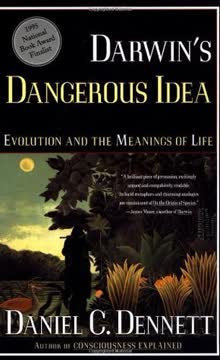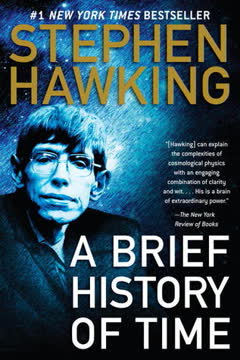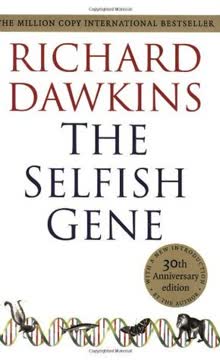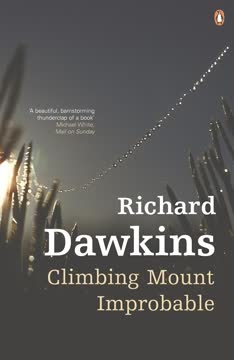Belangrijkste punten
1. Natuurlijke selectie is de blinde horlogemaker, die complexe ontwerpen creëert zonder doel
Natuurlijke selectie is de blinde horlogemaker, blind omdat zij niet vooruitziet, geen gevolgen plant en geen doel voor ogen heeft.
Complexiteit zonder ontwerp. Het schijnbare ontwerp in de natuur, van het ingewikkelde functioneren van het oog tot de gestroomlijnde vorm van een vogelvleugel, is niet het resultaat van een bewuste schepper, maar van natuurlijke selectie. Dit proces, dat miljoenen jaren duurt, kan ongelooflijk complexe en goed aangepaste organismen voortbrengen zonder enige vooruitziende blik of planning.
Natuurlijke selectie werkt via:
- Willekeurige genetische mutaties
- Verschillen in overleving en voortplanting van organismen
- Overerving van gunstige eigenschappen
Illusie van doelgerichtheid. Hoewel de uitkomsten van natuurlijke selectie doelgericht lijken, is dat slechts een illusie. Het proces zelf is volledig mechanistisch en wordt gedreven door directe overlevings- en voortplantingsvoordelen, niet door langetermijndoelen. Dit idee daagt onze intuïtieve opvatting over ontwerp en doel in de natuur uit en vraagt om een andere blik om de kracht van evolutionaire processen echt te begrijpen.
2. Cumulatieve selectie is de sleutel tot het begrijpen van evolutionaire verandering
Cumulatieve selectie, eenmaal begonnen, lijkt bijna onbeperkte kracht te hebben.
De kracht van kleine veranderingen. Cumulatieve selectie is het proces waarbij kleine, stapsgewijze veranderingen zich in de loop van de tijd ophopen en zo grote resultaten opleveren. Dit begrip is essentieel om te begrijpen hoe complexe aanpassingen kunnen ontstaan door een reeks beheersbare stappen, in plaats van ineens.
Belangrijke kenmerken van cumulatieve selectie:
- Elke stap levert een klein voordeel op
- Gunstige veranderingen worden behouden en uitgebouwd
- Het proces kan na verloop van tijd tot spectaculaire resultaten leiden
De analogie van het cijferslot. Dawkins gebruikt de vergelijking met een cijferslot om het verschil te verduidelijken tussen selectie in één stap (pure kans) en cumulatieve selectie. Terwijl de kans om een complexe combinatie zomaar te raden astronomisch klein is, maakt een proces dat feedback geeft over elk cijfer het oplossen van het slot veel haalbaarder. Op dezelfde manier geeft natuurlijke selectie “feedback” via verschillen in overleving en voortplanting, waardoor complexe aanpassingen geleidelijk kunnen ontstaan.
3. DNA is de digitale informatietechnologie van het leven
Er is genoeg opslagcapaciteit in één enkele menselijke cel om de Encyclopaedia Britannica, alle 30 delen ervan, drie of vier keer op te slaan.
Informatieopslag in het leven. DNA is in wezen een digitale code die enorme hoeveelheden informatie opslaat in een opmerkelijk compacte vorm. Deze informatietechnologie vormt de basis van al het leven en bevat de instructies voor het bouwen en laten functioneren van levende organismen.
Belangrijke kenmerken van DNA als informatie:
- Gebruikt vier “letters” (A, T, C, G) om informatie te coderen
- Informatie wordt gekopieerd en doorgegeven aan nakomelingen
- Mutaties kunnen nieuwe variaties introduceren
Gevolgen van de informatiecapaciteit van DNA. De enorme opslagcapaciteit van DNA benadrukt het potentieel voor complexiteit in levende wezens. Het onderstreept ook het belang van informatieoverdracht en -verwerking in de biologie, en legt een parallel tussen leven en door mensen ontworpen informatietechnologieën.
4. Genen werken samen binnen soorten, maar concurreren tussen soorten in wapenwedlopen
Genen worden geselecteerd, niet om hun intrinsieke kwaliteiten, maar vanwege hun interacties met hun omgeving.
Interacties tussen genen. Binnen een soort werken genen vaak samen om gunstige eigenschappen te produceren. Tussen soorten kunnen genen echter betrokken zijn in evolutionaire wapenwedlopen, waarbij ze zich voortdurend aanpassen om de aanpassingen van andere soorten te counteren.
Voorbeelden van genensamenwerking:
- Meerdere genen die samenwerken om complexe eigenschappen te vormen
- Genen voor verschillende delen van een orgaan (bijvoorbeeld het oog) die samen evolueren
Voorbeelden van evolutionaire wapenwedlopen:
- Aanpassingen tussen prooi en predator (bijvoorbeeld snellere cheeta’s versus snellere gazellen)
- Plantenverdediging versus aanpassingen van herbivoren
Belang van context. Dit begrip benadrukt het belang van genen in hun omgevingscontext, inclusief de aanwezigheid van andere genen en concurrerende organismen. Het helpt zowel de harmonie binnen organismen als de voortdurende evolutionaire strijd tussen soorten te verklaren.
5. Seksuele selectie kan leiden tot explosieve evolutionaire veranderingen
De ontwikkeling van het verenkleed bij het mannetje, en de seksuele voorkeur voor zulke ontwikkelingen bij het vrouwtje, moeten dus samen vooruitgaan, en zolang het proces niet wordt tegengewerkt door sterke tegenselectie, zal het steeds sneller gaan.
Ontsnappende selectie. Seksuele selectie, vooral gedreven door de keuze van het vrouwtje, kan leiden tot snelle en extreme evolutionaire veranderingen. Dit proces verklaart de ontwikkeling van extravagante eigenschappen die moeilijk met nut alleen te verklaren zijn, zoals de staart van de pauw.
Mechanismen van seksuele selectie:
- Voorkeur van vrouwtjes voor bepaalde mannelijke eigenschappen
- Concurrentie tussen mannetjes om partners
- Genetische koppeling tussen eigenschap en voorkeurgenen
Positieve feedbacklus. De sleutel tot het begrijpen van explosieve seksuele selectie is het concept van een positieve feedbacklus. Naarmate vrouwtjes een bepaalde eigenschap prefereren, selecteren ze ook voor de genen die ervoor zorgen dat hun dochters die voorkeur erven. Dit kan leiden tot een zichzelf versterkende cyclus van steeds extremere eigenschapsontwikkeling, beperkt alleen door tegenwerkende overlevingsdruk.
6. Evolutionaire verandering is meestal geleidelijk, niet plotseling
Het is volstrekt mogelijk dat onze afgelegen planeet letterlijk de enige is die ooit leven heeft voortgebracht.
Gradualisme versus punctuatie. Dawkins verzet zich tegen het idee dat evolutie vooral verloopt via snelle uitbarstingen van verandering gevolgd door lange perioden van stilstand (punctuated equilibrium). Hij pleit voor een geleidelijker beeld van evolutionaire verandering, waarbij kleine aanpassingen zich in de loop van de tijd ophopen.
Argumenten voor gradualisme:
- De meeste aanpassingen vereisen vele kleine stappen om te evolueren
- Het fossielenbestand lijkt vaak gepunctueerd door onvolledigheid
- Geleidelijke verandering kan op geologische tijdschalen snel lijken
Belang van tijdschaal. Het begrijpen van de enorme tijdschaal van evolutie is cruciaal om de kracht van geleidelijke verandering te waarderen. Wat in het fossielenbestand als een plotselinge sprong lijkt, kan miljoenen jaren van geleidelijke aanpassing vertegenwoordigen.
7. Culturele evolutie vertoont overeenkomsten met biologische evolutie
Memes kunnen zich verspreiden van brein naar brein, van brein naar boek, van boek naar brein, van brein naar computer, van computer naar computer.
Memes als culturele replicatoren. Dawkins introduceert het concept van memes als eenheid van culturele informatie die evolueert op een manier die vergelijkbaar is met genen. Dit biedt een kader om culturele verandering te begrijpen vanuit een evolutionair perspectief.
Overeenkomsten tussen culturele en biologische evolutie:
- Replicatie (ideeën worden van persoon tot persoon gekopieerd)
- Variatie (ideeën veranderen tijdens overdracht)
- Selectie (sommige ideeën verspreiden zich succesvoller dan andere)
Gevolgen van memetische evolutie. Het concept van memes geeft inzicht in de verspreiding van ideeën, technologieën en culturele gebruiken. Het suggereert dat culturele evolutie, net als biologische evolutie, complexe en goed aangepaste resultaten kan opleveren zonder bewust ontwerp. Toch is de analogie tussen genen en memes niet perfect en blijft het concept onder sommige wetenschappers controversieel.
Laatst bijgewerkt:
FAQ
What's The Blind Watchmaker about?
- Explaining complexity in biology: Richard Dawkins explores how complex biological structures can arise through natural processes, specifically through natural selection, without the need for a conscious designer.
- Natural selection as a mechanism: The book presents natural selection as a "blind watchmaker" that operates without foresight, gradually leading to the evolution of complex organisms from simpler ancestors.
- Countering creationist arguments: Dawkins refutes creationist views by illustrating how evolutionary theory provides a robust explanation for the diversity of life, using examples like the eye and echolocation in bats.
Why should I read The Blind Watchmaker?
- Clear and engaging writing: Dawkins presents complex scientific ideas in an accessible manner, making it suitable for both lay readers and those with a scientific background.
- Defending Darwinism: The book offers a vigorous defense of Darwinian evolution, equipping readers with the knowledge to engage in discussions about evolution and creationism.
- Inspiring wonder about nature: Dawkins conveys a sense of awe regarding the complexity of life, encouraging readers to appreciate the beauty of biological systems.
What are the key takeaways of The Blind Watchmaker?
- Natural selection is nonrandom: While mutations may occur randomly, natural selection systematically favors traits that enhance survival and reproduction.
- Complexity arises from simplicity: Dawkins illustrates how complex structures evolve from simple beginnings through small, cumulative changes, essential for understanding life's evolution.
- Importance of intermediate forms: Every complex organ can be traced back through intermediate forms that provided survival advantages, supporting the plausibility of evolutionary theory.
What are the best quotes from The Blind Watchmaker and what do they mean?
- "The only watchmaker in nature is the blind forces of physics.": This quote highlights that natural selection, not a conscious designer, is responsible for life's complexity.
- "If it can be said to play the role of watchmaker in nature, it is the blind watchmaker.": It emphasizes that natural selection shapes life without foresight or intention.
- "Evolution — The Greatest Show on Earth — The Only Game in Town!": Reflects Dawkins' enthusiasm for evolutionary theory as the most compelling explanation for life's diversity.
How does Dawkins explain the concept of cumulative selection in The Blind Watchmaker?
- Cumulative vs. single-step selection: Dawkins distinguishes between random single-step selection and cumulative selection, where each change builds on previous successes.
- Example of the monkey typing: He uses this analogy to illustrate the improbability of achieving complex phrases without cumulative selection, highlighting the power of gradual improvements.
- Real-world implications: Cumulative selection is crucial for understanding how complex traits evolve, showing that small, beneficial changes can accumulate over time.
How does Dawkins address the argument from design in The Blind Watchmaker?
- Critique of Paley's analogy: Dawkins critiques the argument that complexity implies a designer, explaining that natural selection can account for the appearance of design.
- Blind forces of nature: He emphasizes that the "blind forces of physics" are responsible for the complexity in living organisms, challenging the need for a conscious designer.
- Natural selection as a mechanism: Dawkins presents natural selection as a robust mechanism that can explain intricate designs found in nature.
What is the concept of "selfish genes" in The Blind Watchmaker?
- Genes as units of selection: Dawkins introduces the idea that genes are the primary units of natural selection, acting in their own interest to ensure survival and replication.
- Influence on behavior: The "selfish gene" concept suggests that behaviors can be understood as strategies to maximize gene replication, even if they appear altruistic.
- Cultural implications: This idea extends beyond biology, influencing discussions in sociology and psychology about how behaviors are shaped by genetic imperatives.
How does Dawkins explain the relationship between evolution and complexity in The Blind Watchmaker?
- Gradual accumulation of changes: Complexity arises through the gradual accumulation of small, beneficial changes over time, rather than sudden leaps.
- Role of natural selection: Natural selection favors traits that enhance survival and reproduction, leading to increasingly complex adaptations.
- Digital information in DNA: The digital nature of genetic information allows for precise changes that can lead to complex traits, akin to how computer programs evolve.
What is the significance of "arms races" in evolution as discussed in The Blind Watchmaker?
- Predator-prey dynamics: Dawkins uses arms races to illustrate how evolutionary pressures between predators and prey lead to adaptations enhancing survival.
- Positive feedback mechanism: As one side evolves better defenses or strategies, the other must adapt, creating a cycle of continuous improvement.
- Examples in nature: The book provides examples of arms races, highlighting their role in contributing to life's complexity and diversity.
How does Dawkins use the analogy of the "blind watchmaker" throughout The Blind Watchmaker?
- Metaphor for evolution: The "blind watchmaker" serves as a metaphor for natural selection, emphasizing that evolution is an unguided process.
- Contrast with intelligent design: Dawkins contrasts evolutionary processes with intelligent design, arguing that natural selection explains complexity without divine intervention.
- Illustrating complexity: The analogy conveys that while evolutionary outcomes may appear designed, they result from random mutations filtered through natural selection.
What is the "Red Queen effect" mentioned in The Blind Watchmaker?
- Continuous evolutionary pressure: The Red Queen effect describes the need for species to constantly adapt to maintain their status amid evolving competitors.
- Metaphor from Lewis Carroll: Derived from Through the Looking Glass, it illustrates the relentless nature of evolutionary pressures.
- Implications for evolution: This concept highlights the dynamic nature of evolution, where species are in a constant race to keep up with environmental and competitive changes.
How does Dawkins address the concept of "macromutation" in The Blind Watchmaker?
- Definition of macromutation: Dawkins defines macromutations as large-scale mutations that could lead to significant evolutionary changes in a single generation.
- Critique of macromutation theories: He argues against their significance, stating that most beneficial changes are small and gradual, with large mutations often being harmful.
- Examples of macromutations: Dawkins references specific examples to demonstrate that while macromutations can occur, they rarely contribute positively to evolution.
Recensies
The Blind Watchmaker krijgt overwegend positieve recensies vanwege de heldere uitleg van de evolutietheorie en natuurlijke selectie. Lezers waarderen Dawkins’ welsprekende schrijfstijl en zijn logische argumenten tegen het creationisme. Velen vinden het boek verhelderend en prijzen het vermogen om complexe wetenschappelijke concepten begrijpelijk te maken voor een breed publiek. Sommige delen worden als droog of verouderd ervaren. Over het geheel genomen beschouwen recensenten het als een belangrijk werk om evolutie te begrijpen, al blijven sommige religieuze lezers onverminderd sceptisch over Dawkins’ atheïstische conclusies.
Similar Books























